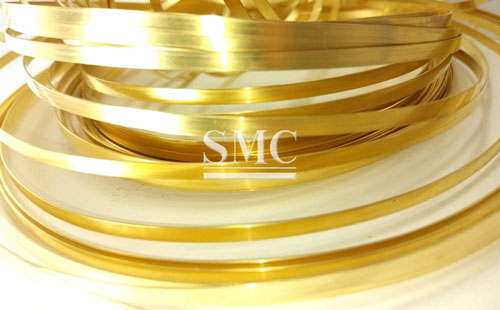Brass is a copper alloy with zinc as the main additive element. It has a beautiful yellow color and is collectively called brass. Copper-zinc binary alloy is called ordinary brass or simple brass. The brass above three yuan is called special brass or complex brass. For alpha brass, both_b and_increase with the increase of zinc content. For (alpha+beta) brass, the room temperature strength increases continuously when the zinc content increases to about 45%. If the zinc content is further increased, the strength of the alloy decreases sharply due to the appearance of more brittle R phase (solid solution based on Cu5Zn8 compound). The room temperature plasticity of brass decreases with the increase of zinc content. Therefore, copper-zinc alloys containing more than 45% zinc have no practical value. Brass alloys containing less than 36% zinc are composed of solid solution and have good cold working properties. For example, brass containing 30% zinc is often used to make cartridge case, commonly known as cartridge case brass or 73 brass. Brass alloys with zinc content ranging from 36% to 42% consist of solid solutions, of which 64 brass with zinc content of 40% is the most commonly used.
Ordinary brass is widely used in water tank belts, water supply and drainage pipes, medals, bellows, serpentine pipes, condensation pipes, cartridge shells and various complex shaped stamping products, hardware and so on. With the increase of zinc content from H63 to H59, they can well withstand thermal processing, mostly used in various parts of machinery and electrical appliances, stamping parts and musical instruments. Brass castings are often used to make valves and pipe fittings.
In order to improve the corrosion resistance, strength, hardness and machinability of brass, a small amount of tin, aluminium, manganese, iron, silicon, nickel, lead and other elements (1%~2%, 3%~4%, 5%~6%) are added to the copper-zinc alloy to form ternary, quaternary or even quinary alloys. Miscellaneous brass, also known as special brass.
Aluminum brass: Aluminum can improve the strength, hardness and corrosion resistance of brass, but reduce the plasticity. It is suitable for marine condenser tubes and other corrosion resistant parts.

Tin brass: Tin can improve the strength of brass and corrosion resistance to sea water, so it is called naval brass, used as ship thermal equipment and propeller. It can dissolve into copper-based solid solution and play a solid solution strengthening role. However, with the increase of tin content, brittle R phase (CuZnSn compound) appears in the alloy, which is not conducive to the plastic deformation of the alloy. Therefore, tin content of tin brass is generally in the range of 0.5% to 1.5%. The commonly used tin brass are HSn70-1, HSn62-1, HSn60-1, etc. The former is an alpha alloy with high plasticity and can be processed under cold and hot pressure. The latter two kinds of alloys have (alpha+beta) two-phase structure, and a small amount of R phase often occurs. The plasticity of the latter two kinds of alloys is not high at room temperature and can only be deformed in hot state.
Lead brass: Lead can improve the cutting performance of brass. This free-cutting brass is often used as clock parts. Lead is actually insoluble in brass and distributed on grain boundaries as free particles. Lead brass has two kinds according to its structure: alpha and (alpha+beta). Alpha-lead brass can only be cold-deformed or hot-extruded because of the harmful effect of lead and its low plasticity at high temperature. (a + beta) lead brass has good plasticity at high temperature and can be forged.
Manganese brass: Manganese has a higher solubility in solid brass. The addition of 1%~4% manganese in brass can significantly improve the strength and corrosion resistance of the alloy without reducing its plasticity.
Manganese brass has (alpha+beta) structure and HMn58-2 is commonly used. The processing performance of manganese brass under cold and hot conditions is quite good.
Iron brass: Iron can improve the mechanical and technological properties of the alloy. Iron content in iron brass is usually less than 1.5%. Its structure is (alpha+beta). It has high strength and toughness, good plasticity at high temperature and deformation at cold state. The commonly used brand is Hfe59-1-1.
Nickel brass: Nickel can significantly improve the corrosion resistance of brass in the atmosphere and sea water. Nickel can also increase the recrystallization temperature of brass and promote the formation of finer grains. Nickel and copper can form continuous solid solution, which enlarges the alpha phase region significantly. HNi65-5 nickel brass has single-phase alpha structure, good plasticity at room temperature and deformation under hot state. However, the content of impurity lead must be strictly controlled, and the hot working performance of the alloy will be seriously deteriorated.
Guest contributors are welcome at the Alloy Wiki.It is a weekly wiki and guide on alloy information and processing technology, while also about the vast array of opportunities that are present in manufacturing. Our team of writers consists of a Machining Material Supplier / Machinist / Tool and Die Maker, a Biomedical Engineer / Product Development Engineer, a Job Development Coordinator / Adjunct Professor, and a President and CEO of a manufacturing facility.
Link to this article:Brief Introduction of Metal Brass
Reprint Statement: If there are no special instructions, all articles on this site are original. Please indicate the source for reprinting:Alloy Wiki,thanks!^^


